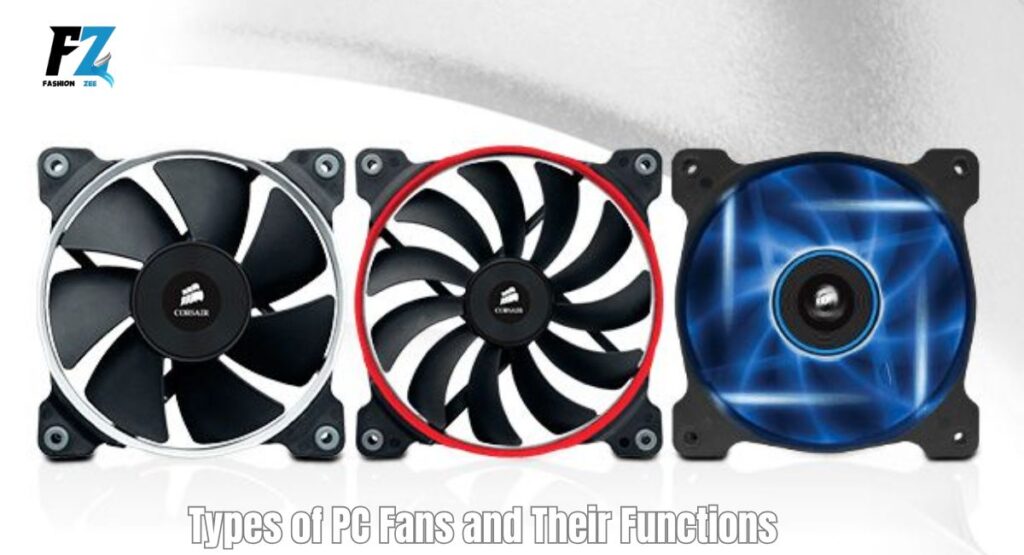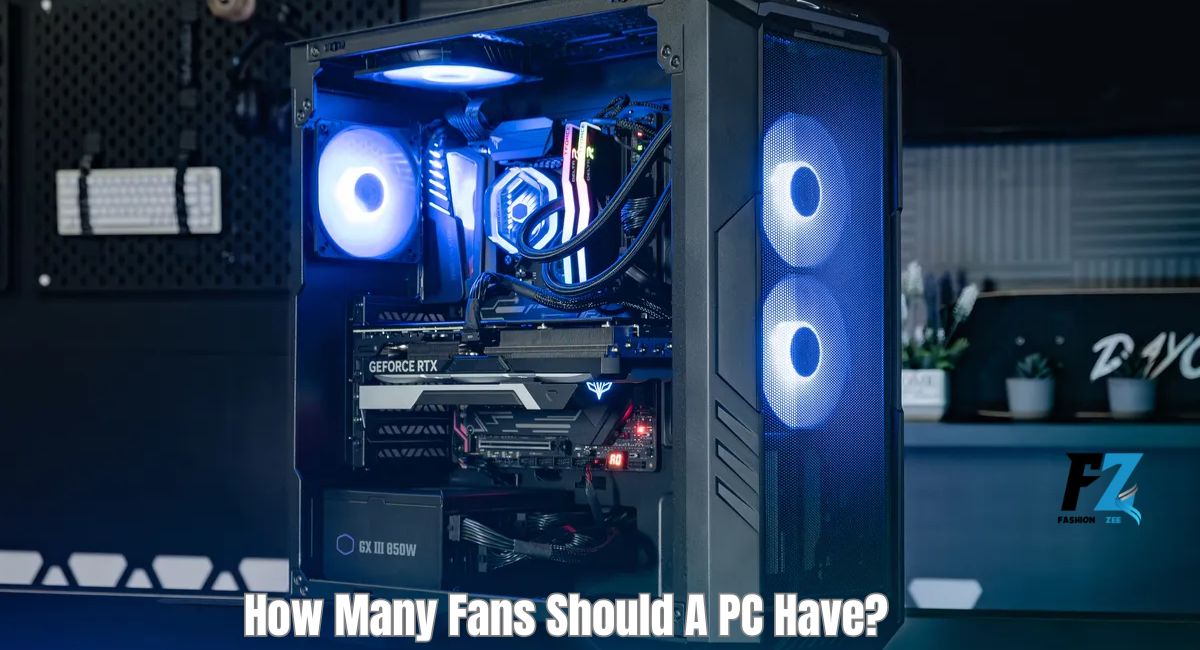Building or upgrading your PC raises important questions about computer cooling. You want maximum performance without the constant worry of overheating. The right number of fans makes all the difference between a system that runs smoothly for years and one that crashes under pressure.
Gaming PC cooling isn’t just about throwing more fans into your case. Smart fan placement and understanding airflow configuration matter more than raw numbers. A poorly designed cooling system with six fans can perform worse than a well-planned setup with just three.
Your components work harder when they stay cool. They also last longer and maintain consistent performance during intense gaming sessions or heavy workloads. This guide breaks down exactly how many fans are needed for different PC builds, from basic office computers to high-end gaming rigs.
You’ll learn to recognize warning signs that your current setup isn’t working. We’ll cover different fan types, placement strategies, and factors that influence your cooling needs. By the end, you’ll know exactly how to create an optimal fan setup for your specific system.
Why Cooling Matters on a PC?
Proper thermal management keeps your expensive components running at peak performance. Modern processors and graphics cards generate significant amounts of heat during operation. Without adequate cooling, this heat builds up and causes problems that range from annoying to catastrophic.
Understanding why cooling matters helps you make informed decisions about your cooling system setup. The relationship between temperature and performance affects every aspect of your computing experience.
1. The Role of Airflow in Performance and Longevity
PC case airflow creates a pathway for heat to escape your system. Cool air enters through intake fans while hot air exits through exhaust fans. This continuous cycle prevents heat from accumulating around sensitive components.
Your CPU and GPU perform best within specific temperature ranges. When temperatures rise beyond these ranges, the components automatically reduce their speed to prevent damage. This process, called thermal throttling, directly impacts your system’s performance.
Consistent heat dissipation also extends component lifespan. Electronic parts degrade faster at higher temperatures. A processor that runs hot for years will fail sooner than one that maintains cooler operating temperatures.
Front to back airflow creates the most effective cooling pattern in most PC cases. This design moves air across all major components in a logical sequence. The air picks up heat as it travels, then exits through rear exhaust fans.
2. Overheating Risks and Component Damage
Overheating protection built into modern hardware prevents immediate catastrophic failure. However, running hot consistently still causes long-term damage that shortens component life.
PC temperature issues manifest in several ways. Your system might crash randomly during gaming or intensive tasks. Performance drops noticeably as components throttle their speeds to reduce heat output.
Extreme overheating can cause permanent hardware failure. Graphics cards are particularly vulnerable because they generate substantial heat in concentrated areas. CPU temperature control prevents processor damage, but consistent high temperatures still accelerate wear.
Component temperatures above safe operating ranges also affect system stability. Memory errors become more common. Storage drives may experience data corruption. Even your motherboard’s voltage regulation can become unstable under excessive heat.
3. Balancing Noise and Temperature
Quiet PC cooling requires finding the sweet spot between adequate cooling and acceptable noise levels. More fans typically mean better cooling but also increased noise.
Fan noise levels vary significantly between different fan models and speeds. High-quality fans with good bearings run quieter at the same RPM. Larger fans can move the same amount of air as smaller ones while spinning slower and producing less noise.
Fan speed optimization through software control helps maintain this balance. Modern motherboards support fan curves that automatically adjust speeds based on temperature readings. This approach keeps your system quiet during light use while ramping up cooling when needed.
Strategic fan placement reduces the need for high-speed operation. Efficient case ventilation allows fans to run at lower speeds while maintaining adequate cooling performance.
Signs You May Need More (or Fewer) Fans
Recognizing the symptoms of inadequate or excessive cooling helps you optimize your system. Your PC communicates its cooling needs through various indicators that become obvious once you know what to look for.
Temperature monitoring software provides the most accurate assessment of your cooling performance. However, other signs can alert you to problems before they become serious.
1. High Internal Temperatures
Consistently high temperatures indicate insufficient cooling capacity. CPU temperatures above 80°C during normal use suggest your current cooling system setup can’t handle the heat load.
Graphics cards running above 85°C under gaming loads also signal cooling problems. These temperatures won’t cause immediate damage but will trigger thermal throttling that reduces performance.
Gaming rig cooling becomes critical during extended sessions. If temperatures climb steadily over hours of play, your system lacks adequate heat dissipation. Adding strategic intake or exhaust fans often solves this problem.
Check temperatures during both idle and load conditions. High idle temperatures suggest poor overall airflow. Load temperatures that climb continuously indicate insufficient cooling capacity for your components.
2. Loud Fan Noise
Excessively loud operation often means your fans work overtime to compensate for poor airflow design. When existing fans run at maximum speed constantly, they can’t provide enough cooling for your system’s needs.
Fan noise levels that interfere with normal computer use indicate an imbalanced setup. Your system might have too few fans, poor fan placement, or inadequate fan capacity for the heat generated.
Conversely, extremely loud operation with good temperatures might suggest too many fans or poor RPM control. Some users install numerous fans without considering whether they actually improve cooling performance.
Gaming PC heat management shouldn’t require jet-engine noise levels. If your system sounds like an aircraft during normal gaming, your cooling configuration needs adjustment.
3. Dust Buildup Patterns
Dust accumulation patterns reveal information about your system’s air pressure and flow characteristics. Heavy dust buildup inside the case despite clean dust filters indicates negative pressure that draws unfiltered air through gaps.
Positive pressure systems show dust primarily on intake filters with relatively clean interiors. This pattern indicates good airflow design that prevents dust from entering through unfiltered openings.
Uneven dust distribution points to dead air zones where circulation is poor. These areas often correspond to hot spots where heat accumulates. Adding fans to improve circulation in these zones can significantly impact cooling performance.
Regular filter maintenance becomes easier with proper pressure balance. Systems with appropriate positive pressure require less frequent internal cleaning.
4. Inconsistent System Performance
PC thermal performance directly affects computing performance. If your system runs smoothly when cold but struggles after warming up, thermal issues are likely the cause.
Gaming performance that degrades over time during sessions indicates thermal throttling. Your GPU or CPU reduces performance to prevent overheating as internal temperatures climb.
Frame rate drops or stuttering that develop gradually point to insufficient cooling capacity. Your graphics card can’t maintain peak performance when temperatures rise beyond safe operating ranges.
Productivity applications that slow down after extended use also suggest thermal problems. Video editing, 3D rendering, and other intensive tasks push components hard and reveal cooling inadequacies.
Types of PC Fans and Their Functions

Different fan types serve specific purposes in your cooling system setup. Understanding these roles helps you choose the right fans for the right locations.
Computer fan installation becomes more effective when you match fan characteristics to their intended function. Each position in your case has different requirements for airflow volume, pressure, and noise characteristics.
1. Intake Fans
Intake fans pull fresh air into your PC case from the outside environment. These fans typically mount on the front panel or bottom of the case where they can access cool ambient air.
Quality intake fans create positive pressure that helps control dust and ensures adequate airflow to components. They work best when paired with dust filters that prevent debris from entering your system.
Improve PC airflow by positioning intake fans to direct cool air toward your hottest components. Most effective installations place intake fans where they can feed fresh air directly to CPU and GPU coolers.
The volume of air moved by intake fans should slightly exceed exhaust capacity. This creates the positive pressure needed for effective dust control and consistent cooling performance.
2. Exhaust Fans
Exhaust fans remove heated air from inside your PC case. They typically mount at the rear or top of the case where they can efficiently expel the warm air that has passed over your components.
Rear exhaust fans work with the natural front to back airflow pattern found in most PC cases. They create the negative pressure needed to draw air through the case in a controlled manner.
Top exhaust fans take advantage of heat’s natural tendency to rise. They’re particularly effective at removing hot air that accumulates near the top of your case around the CPU area.
Case fan configuration works best when exhaust capacity slightly exceeds intake volume. This prevents hot air from stagnating while maintaining controlled airflow patterns.
3. Top-Mounted vs. Front/Rear Fans
Top-mounted fans usually function as exhaust units that remove hot air naturally rising from components below. This placement works well for CPU temperature control since processor heat tends to accumulate in the upper case area.
Front-mounted fans serve as primary intake sources that feed cool air to all system components. They’re essential for gaming PC cooling because they provide the fresh air needed for high-performance components.
Rear fans almost always work as exhaust units that complete the airflow circuit. They create the exit path that allows front intake fans to move air effectively through the case.
Fan placement strategy should follow the natural flow of air and heat within your case. Fighting against these natural patterns reduces efficiency and cooling performance.
4. Case Fans vs. CPU/GPU Fans
Case fans manage overall system airflow and create the environment where component-specific coolers operate. They don’t directly cool individual parts but provide the airflow foundation that makes everything else work.
CPU fans attach directly to processor heatsinks or radiators. They work most effectively when case fans provide adequate fresh air and remove heated air from the CPU area.
GPU cooling solutions are built into graphics cards but depend on case airflow for optimal performance. Graphics cards pull in cool air and exhaust hot air, requiring good case ventilation to prevent heat buildup.
The interaction between case fans and component coolers determines overall thermal performance. Even the best CPU or GPU cooler struggles without adequate case airflow to support its operation.
READ THIS BLOG: How to Maximize ZardGadjets with This Online Tool Guide
Factors That Determine How Many Fans Your PC Needs
Several factors influence your specific cooling requirements. Understanding these variables helps you determine the optimal fan setup for your particular system and environment.
How many fans needed depends on your unique combination of components, case design, and usage patterns. Cookie-cutter recommendations don’t account for these important differences.
1. PC Case Size and Layout
Smaller cases have limited mounting points and restricted internal volume for air circulation. Mini-ITX builds might only accommodate two or three fans while full-tower cases can support eight or more.
Case ventilation design varies significantly between manufacturers and models. Some cases optimize airflow with strategic vent placement while others prioritize aesthetics over cooling performance.
Component proximity in compact cases creates heat concentration that requires more focused cooling. Larger cases allow heat to spread out naturally, reducing the cooling burden on individual fans.
Internal layout affects how air moves through your system. Cases with good cable management space and component spacing need fewer fans than cramped designs with poor airflow paths.
2. Type of Components (High-end vs. Entry-level)
High-performance components generate significantly more heat than entry-level parts. A flagship graphics card might produce three times the heat of a budget GPU, requiring proportionally more cooling capacity.
Heat generation scales with component performance and power consumption. Overclocked components or those running at maximum settings produce even more heat that must be dissipated.
Modern components include better stock cooling than older generations. However, high-end parts still benefit from improved case airflow that supports their built-in cooling systems.
Power supply efficiency also affects heat generation. Higher efficiency units waste less energy as heat, reducing the overall thermal load on your cooling system.
3. Ambient Room Temperature
External temperature directly affects cooling performance since your fans can only cool components to slightly above ambient temperature. PCs in warm rooms need more cooling capacity than those in air-conditioned spaces.
Seasonal temperature changes affect cooling requirements. Systems that run fine in winter might struggle during hot summer months without additional cooling capacity.
Room ventilation impacts the temperature of air entering your PC. Computers in small, poorly ventilated rooms gradually heat up their environment, creating a feedback loop that reduces cooling effectiveness.
Geographic location and climate influence year-round cooling needs. Users in consistently warm climates benefit from more robust cooling systems than those in cooler regions.
4. Overclocking Needs
Overclocked components generate substantially more heat than stock configurations. Fan speed optimization becomes critical when pushing components beyond their factory specifications.
Stability requirements for overclocked systems demand consistent temperatures. Temperature spikes that might not affect stock components can cause instability in overclocked configurations.
Thermal headroom refers to the difference between current operating temperature and thermal limits. Overclocked systems need more cooling capacity to maintain adequate thermal headroom for stable operation.
Stress testing reveals cooling adequacy for overclocked systems. If temperatures climb too high during intensive benchmarks, additional cooling becomes necessary before daily use.
5. Dust Management and Air Filters
Dust filters protect components but restrict airflow compared to unfiltered openings. Systems with comprehensive filtration might need additional fan capacity to compensate for this restriction.
Positive pressure systems require intake fan capacity that exceeds exhaust capacity. This pressure differential prevents dust from entering through unfiltered gaps and cracks.
Filter maintenance frequency affects cooling performance over time. Systems designed with easy filter access encourage regular cleaning that maintains optimal airflow.
Environmental dust levels influence cooling requirements. Computers in dusty environments benefit from positive pressure systems that minimize internal contamination.
General Recommendations: How Many Fans Should a PC Have?
These recommendations provide starting points based on common system types and requirements. Your specific needs might vary based on the factors discussed above, but these guidelines work for most users.
Computer cooling effectiveness depends more on proper placement than raw fan count. A well-designed three-fan system often outperforms a poorly planned six-fan setup.
1. Minimum Fan Setup (Basic Builds)
Basic office computers and media PCs need minimal cooling for their low-power components. One intake fan plus one exhaust fan creates adequate airflow for systems without dedicated graphics cards.
This simple configuration establishes front to back airflow that moves air across the CPU and other components. The intake fan provides fresh air while the exhaust fan removes heated air.
Prevent PC overheating in basic systems by ensuring both fans function properly and aren’t obstructed by dust or cables. Regular maintenance keeps this minimal setup working effectively.
Budget builds benefit from this approach because it provides adequate cooling without the expense of additional fans. The money saved can go toward better components or other system improvements.
2. Optimal Setup (Gaming/Workstation PCs)
Gaming systems and workstations typically need two to three intake fans paired with one to two exhaust fans. This configuration handles the heat from dedicated graphics cards and faster processors.
Gaming PC cooling works best with two front intake fans that provide fresh air directly to the graphics card area. One rear exhaust fan removes heated air while maintaining good airflow balance.
Top exhaust fans help in cases where CPU coolers generate significant heat. They’re particularly beneficial for air-cooled systems with large tower coolers that heat the upper case area.
Reduce computer temperature by ensuring intake fan capacity slightly exceeds exhaust capacity. This creates positive pressure that improves dust control while maintaining effective cooling.
3. High-Performance or Overclocked Systems
High-end systems require comprehensive cooling with five or more strategically placed fans. These setups manage heat from flagship components and overclocked configurations.
Multiple intake fans ensure adequate fresh air supply for power-hungry components. Three front intake fans plus bottom intake fans can provide the airflow needed for dual-GPU systems or heavily overclocked components.
Exhaust fan placement becomes critical in high-performance systems. Rear, top, and sometimes side exhaust fans create multiple heat exit paths that prevent hot air accumulation.
Gaming PC heat management in extreme systems might require custom fan curves and monitoring software. Automatic fan control helps maintain optimal temperatures while minimizing noise during lighter use.
Frequently Asked Questions
How many fans does a gaming PC need minimum?
Most gaming PCs need at least three fans for adequate cooling: two intake fans at the front and one exhaust fan at the rear.
Can too many fans hurt PC performance?
Too many fans won’t hurt performance but may create unnecessary noise and turbulence that reduces cooling efficiency compared to properly placed fans.
Should all PC fans run at maximum speed?
No, running fans at maximum speed constantly creates unnecessary noise and wear. Use automatic fan curves that adjust speeds based on temperature.
Do bigger fans cool better than smaller ones?
Larger fans typically move more air at lower RPMs, providing better cooling with less noise than smaller fans spinning faster.
How often should I clean my PC fans?
Clean PC fans every 3-6 months depending on your environment, or whenever you notice dust buildup affecting performance or increasing noise levels.
Conclusion
Determining how many fans needed for your PC requires understanding your specific components, case design, and performance requirements. Basic systems work well with minimal cooling while high-performance builds need comprehensive airflow management.
The key to effective computer cooling lies in strategic fan placement rather than simply adding more fans. Proper airflow configuration with fewer fans often provides better results than random fan placement with higher quantities.

David is a seasoned SEO expert with a passion for content writing, keyword research, and web development. He combines technical expertise with creative strategies to deliver exceptional digital solutions.







